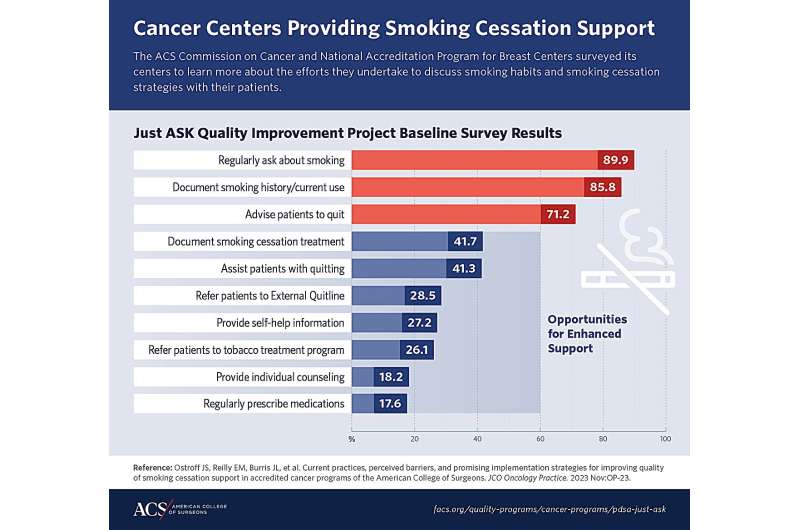This article has been reviewed according to Science X's editorial process and policies. Editors have highlighted the following attributes while ensuring the content's credibility:
fact-checked
trusted source
proofread
Smoking is an undertreated risk factor after a cancer diagnosis

While many cancer centers routinely document and ask about the smoking status of their patients, baseline survey results of a national quality improvement project led by the American College of Surgeons (ACS) describe the many challenges and missed opportunities these centers may face when trying to help patients quit smoking.
The results, published in JCO Oncology Practice, represent one of the largest national surveys examining the quality of tobacco treatment in cancer care in a wide range of clinical oncology settings, including academic facilities and community cancer programs.
"While many people understand the role of tobacco in terms of causing cancer, they may not understand the impact that tobacco use has when patients are being treated for cancer," said Timothy Mullett, MD, FACS, MBA, Chair of the ACS Commission on Cancer (CoC) and co-author of the study.
"Additionally, many providers may not think about tobacco cessation in terms of treatment. But just like there are effective treatments for high blood pressure or thyroid disease, there are effective treatments for tobacco use. That's the disconnect we're trying to highlight in this study."
Persistent smoking among patients diagnosed with cancers is associated with a multitude of treatment-related complications, including recurrence of cancer, poor survival, and increased cancer treatment costs, noted Dr. Mullett, who also serves as medical director of the Markey Cancer Center Network at the University of Kentucky in Lexington, Kentucky.
Despite these risk factors, population-based surveys suggest that nearly 25% of new patients with cancer report current smoking, and of the estimated 18 million cancer survivors in the U.S., 16% report current smoking. Many patients report wanting to quit smoking, but fewer than 10% of patients are successful at quitting.1-3
The Just ASK Quality Improvement (QI) project was initiated by leaders of the CoC and American College of Surgeons National Accreditation Program for Breast Centers (NAPBC) in 2022 to strengthen the adoption of universal assessment and documentation of smoking status in electronic health records.
Physicians, nurses, and other clinic staff were encouraged to ask all patients about current smoking and advise patients that quitting can improve cancer outcomes. Just ASK Task Force members developed online surveys to assess several aspects of tobacco cessation, including an assessment of current practices and implementation barriers.
Baseline survey findings of the JUST Ask QI project
- Of approximately 2,000 invited programs, 776 programs (approximately 40%) accredited by the CoC or NAPBC enrolled and completed the baseline survey. The authors write that this participation rate is on par with other national QI projects and demonstrates that smoking assessment/treatment is a high national priority for QI in cancer care.
- Despite the near-universal endorsement of its clinical importance, the authors found high variability in the routine and widespread implementation of smoking assessment and treatment, underscoring a persistent gap in quality cancer care delivery across the U.S.
- Most programs reported regularly asking patients about smoking (89.9%), documenting smoking history and current use (85.8%), and advising patients to quit (71.2%). However, less than half of the programs reported documenting a smoking cessation treatment plan (41.7%). Even fewer programs reported regularly assisting patients with quitting (41.3%), providing self-help information (27.2%), providing individual counseling (18.2%), and referring patients to an affiliated tobacco treatment program (26.1%) or external Quitline (28.5%).
- Very few programs reported regularly prescribing medications (17.6%).
- The facilities reported several principal barriers to tobacco treatment delivery, including a lack of staff training (68.8%), lack of designated specialists (61.9%), perceived patient resistance (58.3%), lack of available resources (53.3%), competing clinical priorities (50.9%), inadequate program funding (40.6%), insufficient staff time (42.4%), and inadequate reimbursement (31.0%).
"With the Just ASK Quality Improvement project, we showed that incorporating tobacco treatment into cancer treatment is feasible and that it can be done in large and small programs," Dr. Mullett said.
"Incorporating resources and referrals on tobacco treatment into cancer care requires training and time. Both of those are hard to find in a busy cancer practice, but we need information like this to be recognized by facilities so they can put resources into tobacco treatment and help connect patients with effective resources on tobacco cessation."
Incorporating evidence-based tobacco treatment in cancer care
The authors outline several recommendations to improve the quality of tobacco treatment for patients with cancer, including:
- Have a proactive system in place for screening patients about their current smoking status.
- Provide greater attention to staff training to help centers adopt best practices for tobacco treatment throughout diverse cancer care settings.
- Establish learning collaboratives or communities to accelerate the implementation of clinical practice guidelines for tobacco treatment and tailor these initiatives to local settings.
- Identify and provide local referrals and other community resources to advise patients about smoking cessation.
More research is needed to evaluate implementation strategies aimed at improving evidence-based tobacco treatment in diverse cancer care settings, the authors said. A second QI project led by the CoC called Beyond Ask, is focused on building programs' capacity to offer cessation assistance to newly diagnosed cancer patients who report currently smoking. The results of that QI project are forthcoming.
"We are at the transition point of needing to transform the knowledge of what we know to how we do it," said first author Jamie Ostroff, Ph.D., former chief of behavioral sciences service and director of the tobacco treatment program at Memorial Sloan Kettering in New York. "With data and expert input, we will be able to develop and test strategies to close that gap between what we know is a best practice and what we observe is happening."
More information: Jamie S. Ostroff et al, Current Practices, Perceived Barriers, and Promising Implementation Strategies for Improving Quality of Smoking Cessation Support in Accredited Cancer Programs of the American College of Surgeons, JCO Oncology Practice (2023). DOI: 10.1200/OP.23.00393



















